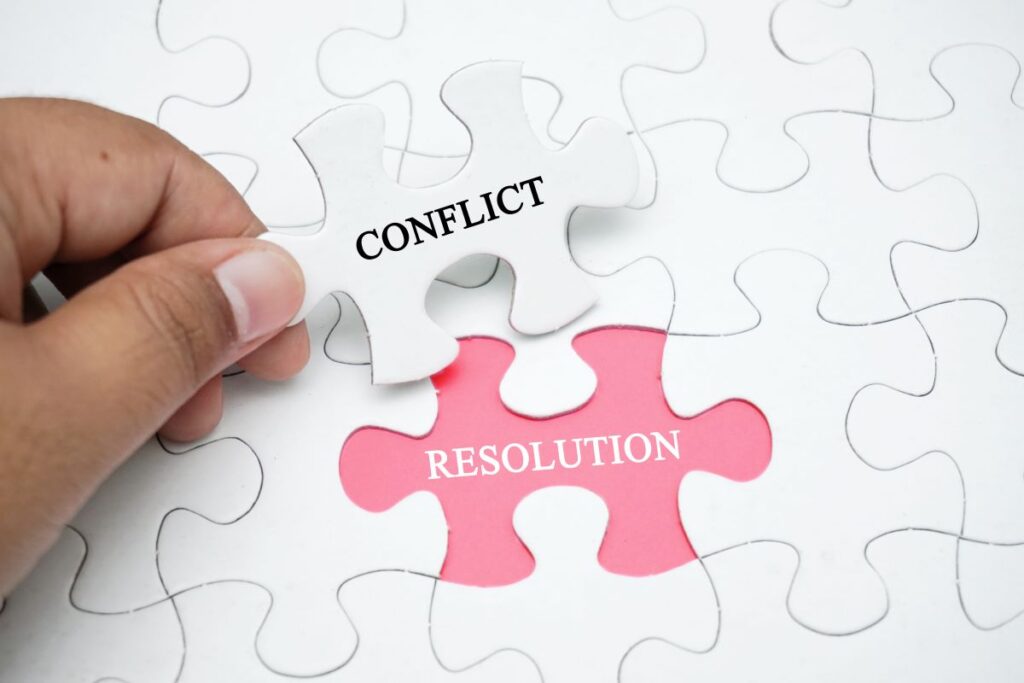What is Conflict Resolution?
Conflict resolution is a process, which can be formal or informal, in which two or more parties work through a process to resolve a disagreement and work toward a feasible solution in education. Both standard and informal conflict resolution are common in schools. Whenever a large group of individuals work together even with open minds and shared goals, conflicts will arise.
It is important to note that not all conflict is negative, as some conflicts can lead to growth and new ideas. If every staff member always agreed, it would be difficult to advance and grow. When handled tactfully, conflict can advance an organization and infuse new ideas.
Formal conflict resolution occurs in schools when one or more parties file a grievance-type procedure against another person of group according to district policy. The complaint then advances to a compliance officer who works to hear both sides in an impartial manner. The compliance officer then applies district policies and what is in the best interest of the school in light of the complaint. A decision is then rendered, and ongoing monitoring of the situation occurs. This type of conflict resolution is less likely to result in growth and both parties coming together.
Informal conflict resolution occurs frequently in even the most student-centered schools. Ideas of how to best proceed only sometimes reach consensus. Individuals can get hurt. Even small conflicts rarely get better when ignored. School leaders must acknowledge conflict. If not, the conflict normally grows and causes damage to the school’s culture and climate. School leaders must bring vested parties together. The leader should proceed with an open mind and listen to both sides.
Active listening without judgment is crucial. As the resolution process proceeds, the leader needs to model respect and be empathetic to the feelings of all parties. Communication must be genuine, clear, and concise.
The leader will help those involved reach common ground and understand the feelings of the other side. Conflicts arise among students, parents, staff, and the community. When all stakeholder relationships are positive students benefit from a healthy culture. School leaders should not take conflict personally.
Why is Conflict Resolution Important in Schools?
School leaders are human beings. Humans generally want to avoid conflict. Yet, educational leaders must challenge themselves to be proactive, as conflict only goes away over time. In actuality, conflict is often like a snowball going downhill growing larger, gaining traction within the learning community, and drawing additional stakeholders in the conflict. If conflict is not managed effectively, a toxic culture can take hold within a school.
In these times, bold leadership that is calculated, confident, and student-centered is imperative. Students benefit academically and socially in a positive school culture that places students’ needs first.
Significant research ties increased academic performance and growth with a positive school culture and climate. If handled appropriately, conflict resolution can actually add to the overall school climate as staff become confident that their leader works to mediate difficult situations toward the outcome that is best for the learning community. It is not healthy to have everyone agree at all times as professionally handled disagreement can be for the betterment of the school community.
Proper conflict resolution brings the community together in pursuit of common goals. Leaders need to model the way and not become emotional, but rather should be welcoming and transparent. If there is conflict regarding a strategic initiative, the principal needs to listen to the opposition’s concerns. Even if you proceed with the initiative, the opposition will feel heard and their concerns can lead to greater refinement in the initiative.
How to Create a Culture of Peace in Schools
Improving school culture can be challenging, but the outcome is certainly worth the effort. A culture of peace with a priority on developing productive and strong stakeholder relationships is essential for student success. Further, being a part of a peaceful, caring learning community helps students develop heightened emotional intelligence, which will lead to them being better prepared to become contributing members of society.
The first step in promoting a culture of peace is to hire a school leader who models this vision and remains positive in spite of challenges. These leaders see challenges as opportunities. The leader needs to challenge actions of others that do not align with this culture. Gratitude and support will build within the school family. Not only will students grow within this environment, but staff will work harder to contribute and will generally be happier at work. As such, these efforts will lead to heightened staff retention and make recruitment more feasible.
Families celebrate successes and overcome challenges together. Schools with peaceful cultures become families who work together to advance common goals. These common goals become a living strategic plan and vision for the learning community.
To sustain a positive climate, leaders must prioritize relationships. These learning communities need to be fun and engaging. Music and movement are powerful means to uplift spirits. Staff retreats add tremendously to the school climate. Leaders should consider faculty retreats including going to movies and plays, planning pool parties, celebratory dinners, and frequent fellowship luncheons. Similarly, school faculties must plan celebrations and bonding events for students. Leaders should work to immerse students and staff within the culture of the learning community. These efforts are investments that will lead to a culture of peace within the school.
Trust earned among stakeholder groups will sustain a positive school climate. It is important to note that peaceful school climates with positive cultures are earned over time but can be damaged within seconds. As such, school leaders need to be cognizant of their actions and words.
A graduate degree in administration prepares you to lead as a principal, superintendent or other school administrator and help shape the future for generations of students. Check out our available leadership and administration graduate degrees and get started today!




